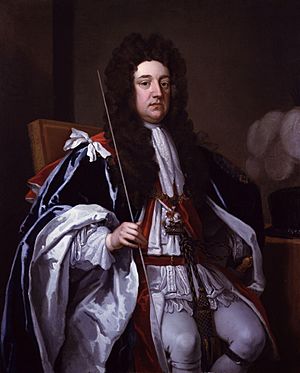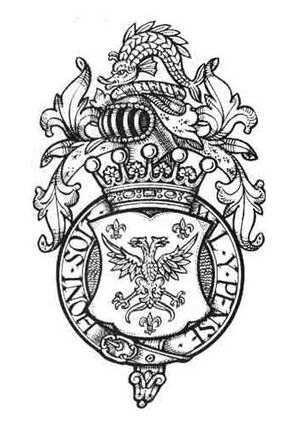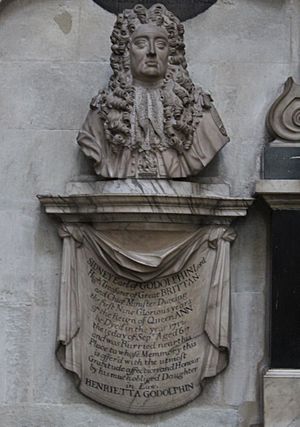Sidney Godolphin, 1st Earl of Godolphin facts for kids
Quick facts for kids
The Earl of Godolphin
|
|
|---|---|

Portrait by Godfrey Kneller
|
|
| Lord High Treasurer | |
| In office 8 May 1702 – 11 August 1710 |
|
| Monarch | Anne |
| Preceded by | The Earl of Carlisle as First Lord of the Treasury Commission |
| Succeeded by | The Earl Poulett as First Lord of the Treasury Commission |
| First Lord of the Treasury | |
| In office 9 December 1700 – 30 December 1701 |
|
| Monarch | William III |
| Preceded by | The Earl Tankerville |
| Succeeded by | The Earl of Carlisle |
| In office 15 November 1690 – 1 June 1699 |
|
| Monarch | William III and Mary II |
| Preceded by | Sir John Lowther |
| Succeeded by | Charles Montagu |
| In office 9 September 1684 – 16 February 1685 |
|
| Monarch | Charles II James II |
| Preceded by | The Earl of Rochester |
| Succeeded by | The Earl of Rochester as Lord High Treasurer |
| Member of Parliament for Helston |
|
| In office September 1679 – 1685 Serving with Sir Vyell Vyvyan (1679–1681)
Serving with Charles Godolphin (1681–1685) |
|
| Monarch | Charles II James II |
| Preceded by | Sir William Godolphin |
| Succeeded by | Sidney Godolphin |
| In office 1665 – February 1679 Serving with Sir William Godolphin
|
|
| Monarch | Charles II |
| Preceded by | Sir Peter Killigrew |
| Succeeded by | Sir Vyell Vyvyan |
| Personal details | |
| Born |
Sidney Godolphin
15 June 1645 Breage, Cornwall, Kingdom of England |
| Died | 15 September 1712 (aged 67) St Albans, Hertfordshire, England, Kingdom of Great Britain |
| Political party | Tory |
| Spouse | Margaret Blagge |
| Children | Francis Godolphin |
| Parents | Sir Francis Godolphin (1605–1667) Dorothy Berkeley |

Sidney Godolphin, 1st Earl of Godolphin (born June 15, 1645 – died September 15, 1712) was an important English politician. He was a member of the Tory party. Godolphin held many key roles in the government, including Lord High Treasurer, which meant he was in charge of the country's money. He played a big part in creating the Kingdom of Great Britain by helping to pass the Acts of Union 1707 with Scotland.
Contents
Early Life and Start in Politics
Sidney Godolphin came from an old family in Cornwall, England. His father was Sir Francis Godolphin (1605–1667). After the English Restoration (when the monarchy was brought back), King Charles II of England brought Godolphin into the royal household.
Godolphin also became a member of the House of Commons, representing Helston. Even though he didn't speak much, his words were always clear and helpful. People quickly saw him as the main expert on money matters in Parliament.
In 1668, he helped King Charles II make a deal with King Louis XIV of France. This deal involved England moving away from its Dutch allies in exchange for money from France. In 1670, Godolphin became a "Groom of the Bedchamber," a special helper to the King, and received a yearly payment. King Charles II liked Godolphin because he was always there when needed but never caused problems.
In 1672, King Charles sent Godolphin to France to assure Louis XIV of England's support before France attacked the Dutch. Godolphin was with Louis during the Franco-Dutch War.
Important Roles in Government
In March 1679, Godolphin joined the Privy Council of England, a group of advisors to the King. By September, he was given a top role in managing the country's affairs.
In 1680, Godolphin voted for the Exclusion Bill. This bill aimed to stop the Catholic Duke of York from becoming king. Even though he supported this, he kept his job. In September 1684, he was given the title Baron Godolphin of Rialton. He then became the First Lord of the Treasury, a very powerful financial position.
When James II of England became king, Godolphin became the chamberlain (a senior official) to the queen, Mary of Modena. He was one of the King's most trusted advisors.
Working with William III and Queen Anne
After William of Orange arrived in England, Godolphin was one of five people chosen by King James to represent him in London. He also helped negotiate with William. When William became king, Godolphin continued to hold important roles in the government, even though he was a Tory.
Godolphin worked closely with John Churchill, who later became the Duke of Marlborough. They were nicknamed "the Duumvirs" because they worked together so well.
When Queen Anne became queen, Godolphin was appointed Lord Treasurer in 1702. He held this important job for eight years. Sarah Churchill, the Duchess of Marlborough, said that Godolphin taught Queen Anne everything she knew about politics. In 1704, he was made a Knight of the Garter. In December 1706, he was given the titles Viscount Rialton and Earl of Godolphin.
Godolphin and Marlborough were very important to the country. However, their influence with the Queen slowly decreased. Eventually, Queen Anne dismissed Godolphin from his job on August 7, 1710.
Sidney Godolphin passed away two years later, in 1712. He is buried in Westminster Abbey, a famous church in London. There is a statue of him there by sculptor Francis Bird.
Family Life
On May 16, 1675, Sidney Godolphin married Margaret Blagge. She was a very religious woman whose life story was written by John Evelyn in his book The Life of Mrs Godolphin.
Margaret died in 1678 while giving birth to their only son. Godolphin never married again after her death. Margaret is buried in Breage, Cornwall.
- Francis Godolphin, 2nd Earl of Godolphin (1678–1766)
Legacy and Importance
Historians believe that Sidney Godolphin was a very important figure in English history.
He was known for being hard-working and very good with money. He helped manage the country's finances and made the Treasury more efficient. He also worked to reduce corruption.
Godolphin was a key partner to the Duke of Marlborough. Together, they helped England succeed during the War of the Spanish Succession.
He also played a major role in creating the United Kingdom of Great Britain by helping to pass the Act of Union with Scotland. Additionally, he helped create a unified East India Company, which was important for Britain's future in India.
Images for kids
-
Sidney Godolphin, 1st Earl of Godolphin by Godfrey Kneller





